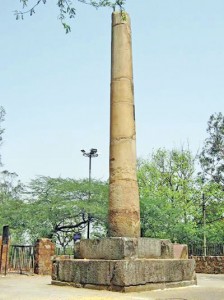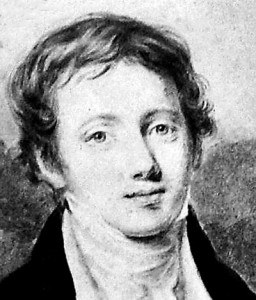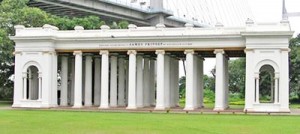An Englishman sets out to ‘discover’ King Asoka
It might be difficult to imagine it today, but 180 years ago nobody really knew anything authentic about King Asoka. To explain what I mean it might be best to say that there are two king Asokas; the Asoka of legend and the Asoka of history.
The first of these Asokas has, of course, been familiar to Buddhists for centuries. He is mentioned in the Dipavamsa, the Mahavamsa and a Sanskrit work called the Asokavadana purports to be a biography of him.
Asoka of legend & Asoka of history
When the Chinese pilgrims Faxian and Xuanzang were in India in the 5th and 6th centuries respectively, the Buddhists they met told them numerous stories about the king.

The much broken Asoka pillar Princep used to desipher the Brahmi script
The pilgrims were also shown massive pillars, stupas and in some cases monasteries supposedly built by Asoka. Chinese Buddhists were so taken by what they heard about the king and his building of 84,000 stupas and temples that they came to believe that some of them were in their own country.
During the Western Jin Dynasty (265-316) someone ‘discovered’ a document to this effect and the emperor ordered his ministers to find them. They embarked on what amounts to probably the earliest archaeological excavations in history and actually unearthed the foundations of twelve such temples in different parts of the country.
As no records of these temples could be found, it was assumed that they had been the ones built in the distant parts by agents sent from India by King Asoka. The oldest of these temples still exists; it is in Ningbo City in Zhejing Provence and was ‘rebuilt’ in 282, although renovated many times since.
But the reality is that the Asoka of legend and tradition is quite different from the second Asoka, the Asoka of history, the real Asoka.
True, this first Asoka is praised for his efforts to promote Buddhism and for his ambitious building programmes, but these traditional accounts about him are completely silent concerning the very thing that Asoka is known and praised for today – his dramatic conversion, his renunciation of war, and his efforts to establish a righteous society.
The traditional accounts praise Asoka primarily for his extravagant gifts to the Sangha, but his contribution to peace and the general welfare of his subjects are for the most part ignored.
Nor is there any mention of his dramatic conversion to Buddhism on seeing the death and misery caused by his war with Kalinga. None of this gets a mention in the Dipavamsa, the Mahavamsa, the Asokavadana or any other traditional Buddhist source.
So much for the first Asoka! But where did the second Asoka, the one we are most familiar with, the one known even to non-Buddhists and people with little interest in Indian history, come from?
1819-James Princep goes to India
Englishman James Princep was born in 1799 and went to India in 1819 where he got a job as an assay master in the Calcutta mint. A year later he was sent to work in the Mint at Benares where he stayed until 1830.
In 1833 he called for reforms to Indian weights and measures and advocated a uniform coinage based on the new silver rupee of the East India Company. He also devised a balance so delicate as to measure three-thousandth of a grain, a remarkable achievement at the time.
Typical of the best type of Englishmen who went to the East in those days, he had wide-ranging interests. A talented artist and draftsman, he made meticulous sketches of ancient monuments, astronomical instruments, he kept records of the weather, etc.
He was interested in understanding weather and he designed a modified barometer that automatically compensated for temperature. He maintained meteorological registers, apart from supplying barometers to volunteers and graphically summarising the records of others.

James Princep as a young man
He also conducted experiments on practical methods to prevent rusting of iron surfaces. But Princep’s consuming interest was numismatics, the study of coins.
Various British soldiers and administrators began sending him ancient coins which they found as they toured the countryside and explored long neglected ruins.
It should be remembered that at this time very little was known about the history of India before the Muslim period. It was not even certain that the Buddha, known to be a ‘god’ worshipped in China, was an Indian.
The main reason for this was that no one, including the Indians themselves, could read the country’s numerous ancient scripts found on coins and in inscriptions.
In 1832 Princep became editor of the Journal of the Asiatic Society which put him into contact with others interested in India’s distant past and the many antiquities they were bringing to light.
With enormous skill and patience, not to say a great deal of brilliant guess-work, Princep managed to decipher numerous ancient scripts, gradually piecing together details of India’s past forgotten for centuries.
Breakthrough: Deciphering an ancient inscription
In 1837, after six years of ingenuity and determination, Prinsep succeeded in deciphering an ancient inscription on a large, much damaged, stone pillar on the ridge in Delhi. The inscription was in a script later called Brahmi, which seemed to bear little resemblance to other Indian scripts, ancient and modern.
Several other pillars and rocks with similar inscriptions had been known for some time and had attracted the curiosity of scholars. Prinsep’s inscription proved to be a series of edicts issued by a king calling himself “Beloved-of-the-Gods, King Piyadasi” the monarch we know as Asoka.
There were several steps that helped Princep decipher the Brahmi script. The key one was this. He had been working on the assumption that the inscription of the pillar was in Sanskrit, but the researches of George Turnour in Sri Lanka made him consider that it was actually closer to Pali, the language of Theravada Buddhism.
King Asoka: a more complete picture
In the following decades, more and more edicts by this same king were discovered and with increasingly accurate decipherment of their language, a more complete picture of this man and his deeds began to emerge.
Gradually, it dawned on scholars that the King Piyadasi of the edicts might be the King Asoka so often praised in Buddhist legends and in chronicles such as the Dipavamsa and the Mahavamsa.
Princep made numerous contributions to Indian numismatics, history and chronology but his decipherment of King Asoka’s inscriptions was by far the most important. Knowledge of this monarch, previously forgotten for centuries, demonstrated that the Buddha’s Dhamma could be, and indeed had once been, applied to the social domain.
It gave a Buddhist a model of righteous governance. And it gave to the world an almost unique example of a powerful king who renounced violence.

Princep Ghat beside the river in Kolkata
Prinsep did not live for long after his great discovery. He literally worked himself to death. From 1838 he began to suffer from a recurrent sickness. It was initially thought to be related to a liver (bilious) condition and he was forced to get away from his studies and left for England in November 1838.
He arrived in England in frail condition from which he never recovered.He died on April 22, 1840 at 31 Belgrave Square of what was then known as a “softening of the brain”.
One of his earlier admirers and helpers, Alexander Cunningham, inspired by his friend’s interest in India’s past, went on to discover several places related to the Buddha, thus helping to prove the historical reality of the Buddha.
Today, a beautiful neo-classical memorial to James Princep called Princep Ghat can still be seen by the Hoogli River in Kolkata. For years much neglected, this monument has recently been renovated.


